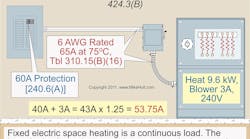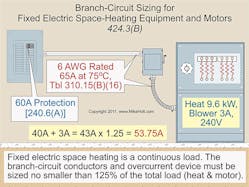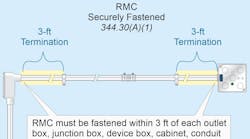Q. How are the branch circuit conductors and overcurrent protection sized for fixed electric space-heating equipment? Please provide an example.
>Find the Answer
A. For the purpose of sizing branch circuit conductors, fixed electric space-heating equipment is considered a continuous load [424.3(B)]. The branch circuit conductors and overcurrent devices for fixed electric space-heating equipment must have an ampacity not less than 125% of the total heating load [210.19(A)(1) and 210.20(A)]. Let’s run through an example problem to show you exactly how to make these calculations.
What size conductor and overcurrent device are required for a 9.6kW, 240V fixed electric space heater that has a 3A blower motor with 75°C terminals?
Step 1: Determine the total load.
I = VA ÷ E = 9,600VA ÷ 240V = 40A
I = 40A + 3A = 43A
Step 2: Size the conductors at 125% of the total current load [110.14(C)(1), 210.19(A)(1), and Table 310.15(B)(16)].
Conductor = 43A x 1.25 = 53.75A
A 6 AWG conductor is rated 65A at 75°C
Step 3: Size the overcurrent device at 125% of the total current load [210.20(A), 240.4(B), and 240.6(A)].
Overcurrent protection = 43A x 1.25 = 53.75A
The next size up is 60A.
Therefore, the answer is to use a 6 AWG conductor and a 60A overcurrent protection device.





